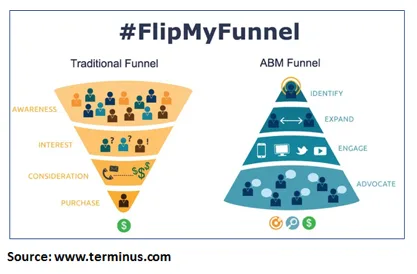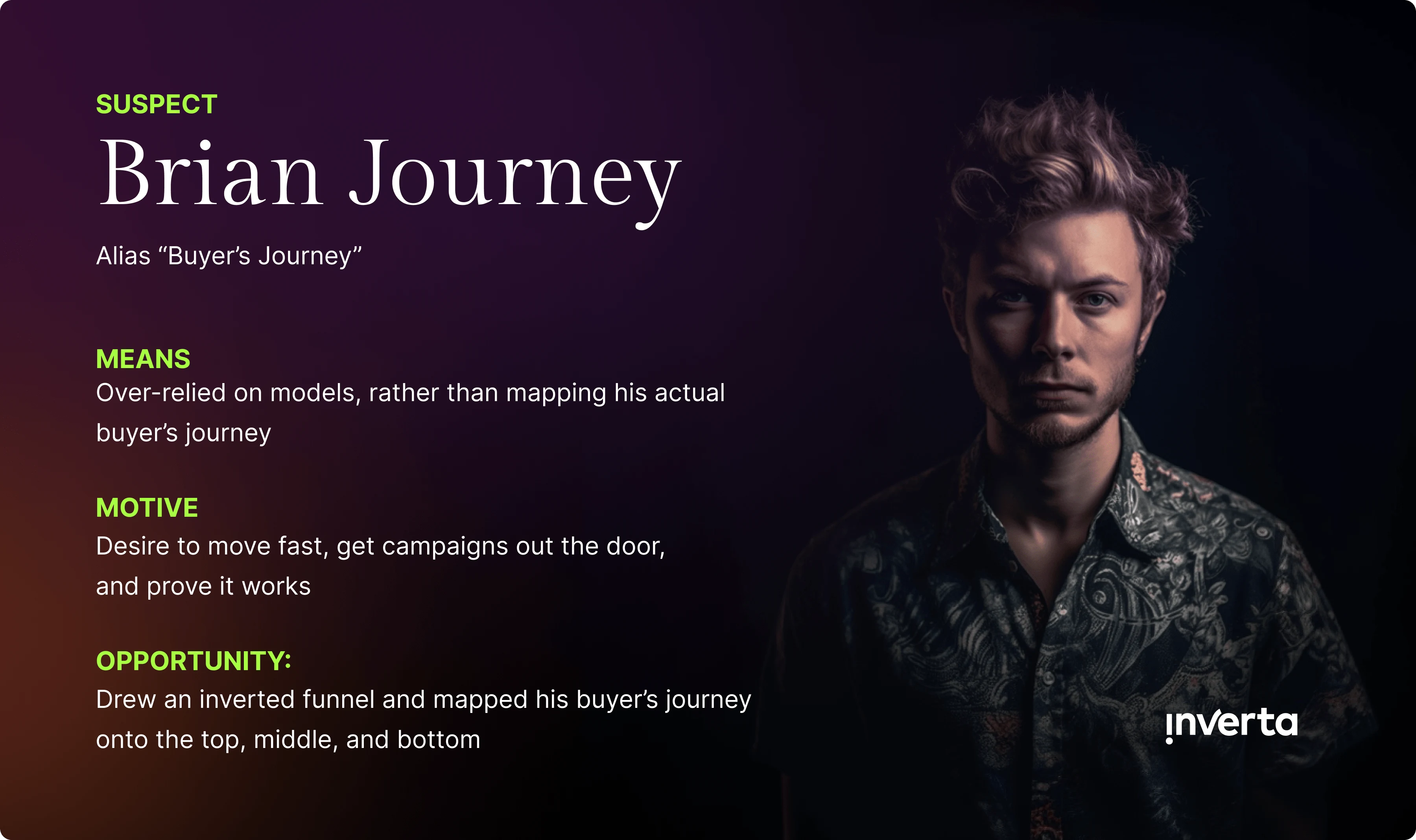The Hound of the Buyer’s Journey

In our last episode, we investigated our first suspect, Vega List. While some clues pointed to her tampering with the target account list, she claims to have an alibi and cites her roaring successes with building a target account list for a 1:1 ABM program as proof that she couldn’t possibly have killed ABM. But what if Vega List wasn’t acting solo? It’s time we paid a visit to her longtime friend and collaborator, Brian Journey, alias "buyer's journey." It’s no secret that Brian Journey and ABM did not fully understand each other, nor see eye to eye. Let's see what Brian has to say for himself.
The next clue: an upside-down funnel drawing
Perhaps the most recognizable artifact to come out of the ABM movement was the image of the “inverted funnel.” Playing off the traditional B2B “awareness, interest, consideration, evaluation, and purchase” funnel, ABM proposed “flipping” this framework upside down (remember FlipMyFunnel?). The idea was that you would choose your best-fit prospects first, then nurture them to become customers and advocates. This ran contrary to digital-era thinking which proposed sending your message to the largest possible audience, then having prospective buyers filter themselves out if it wasn’t a good fit.

The inverted funnel is a useful model for understanding how ABM works. It looked extremely attractive on a presentation slide (“turn that funnel—click—upside down!”). But it’s just that, a model. And as British statistician, Geoge Box once said, “All models are wrong, some are useful.”
“All models are wrong, some are useful.” —George Box
Being successful at ABM means actually applying the model by investigating your own buyer’s journey. To do that, you need to interview customers and use data to understand how they’re engaging, what content they care about, and what a typical path to purchase looks like. For more on this type of pursuit in buyer journey, marketers must embrace deeper research and behavioral insight rather than surface-level metrics.
But most organizations didn’t take the time to do this legwork to accurately define their buyer’s journey. This too, was part of the abandonment of long-held marketing principles that came about as a result of the digital era, as we’ve already covered in our previous episodes. A 2002 study reported that 54 percent of companies did not recognize customer behavior in their marketing planning efforts. By 2009, researchers were sounding the alarm that the “gold standard” of customer research, behavior analysis, and segmentation was at risk as marketers pivoted towards shiny, new, but ultimately less effective, digital information-gathering techniques.
By the time ABM came to prominence in the mid-2010s, these research capabilities were all but forgotten. Many teams, unequipped to do real research on their buyer’s journey, simply applied the theory of the funnel by labeling the “top,” “middle,” and “bottom,” of their buyer’s journey and calling it a day.
As a result, they ended up applying the same old demand generation playbook—just on a smaller list of accounts. For instance, instead of targeting 10,000 accounts with the same message, they just focused on 1,000. Or worse, now that they were hyper-focused on pipeline, every call-to-action (CTA) became “book a meeting,” regardless of whether the customer was ready for that step or not.
What this approach missed was a more thoughtful breakdown by audience and what each group really wanted (and needed) to hear. This meant that marketing teams were unable to effectively align with sales on how each team should engage at each phase, craft compelling messaging, or share content that aligned with their prospects’ most pressing questions. This failure to listen properly is what some experts call the buyer journey chase—a pattern of chasing signals instead of truly hearing buyer intent.
So while everyone was inviting Brian Journey to their parties, Brian was quietly uninviting ABM, telling others she was busy, or couldn’t make it. They were rarely in the same room. And Brian liked it that way.
We seem to be building a case against Brian Journey, but before we go any further, let’s see what he has to say for himself.
Brian Journey’s alibi
“Now hold on a second,” Brian Journey sputters. “You’ve got me all wrong. I’ll be the first to admit that I made mistakes in the past, but I’ve learned from them. Would you let me tell my side of the story?”
We nod, gesturing for him to go ahead.
“When I started at Conan Doyle Industries,* we didn’t have robust buyer’s journey data or a concrete plan. We were focused on generating demand through volume plays. I knew we needed to get our act together and build a much stronger foundation of research before we could hope to execute ABM—er, poor choice of words.”
We interject: “So, what did you do?”
“I’m getting to that,” says Brian. “We did a deep dive into our customer research, for the first time in a long time, maybe ever. All of a sudden we were pulling up our data and asking ourselves foundational questions like: Who do we sell to? How do we talk to them? How long is our sales cycle? How many people are on the buying committee?”
“Through all that effort, we were able to determine that we had nine distinct segments. Starting with the one we determined was the lowest risk, we decided to launch an always-on 1:many ABM campaign. To do that, though, we needed a detailed map of the buyer’s journey, which we created.”
He pulls out a crumpled, but legible document:

“See that?” he continues. “Detailed entry and exit points for each phase. Messaging. CTAs. Content types. It’s all here. We even sat down with sales to come up with a concrete plan for how we’d both engage at each phase.”
“This is very thorough,” we admit, scanning the document. “You’ve given us a lot to consider, Brian Journey. Thank you for your time.”
Brian admits that he didn’t always have a clear map of his buyer’s journey, but claims he’s changed his ways. But do we believe him?
So, did Brian Journey kill ABM?
This does poke some holes in our theory. While Brian Journey might have side-stepped the effort needed to accurately map his customers’ buying journeys at some companies, the evidence from Conan Doyle Industries seems watertight.
This case study does not paint the picture of someone sloppily labeling an inverted funnel and calling it a day. If he was going to kill ABM, why go to all that work? Something doesn’t add up.
It seems that we still have more investigating to do—and with five suspects left to question, this case is far from closed.
Join us in two weeks where we’ll investigate Strata Ji (alias “strategy”). Until then, what do you think? Did Brian Journey kill ABM? Cast your vote below.



